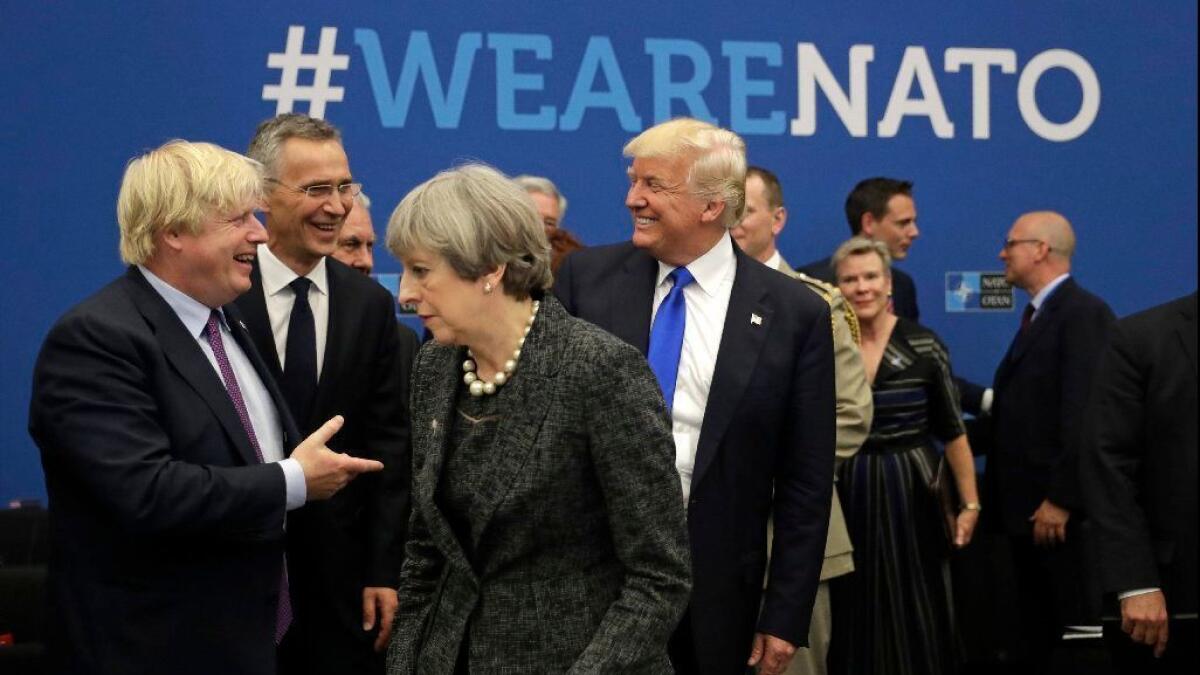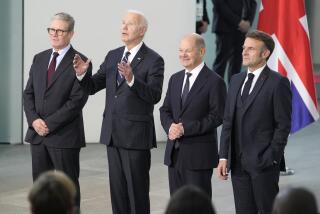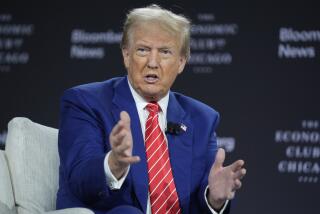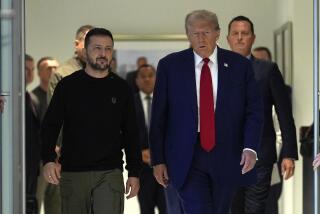Trump heads to Europe amid frayed alliances, and worries about his tilt to Putin

Reporting from Washington — President Trump rattled foreign allies last month when he angrily refused to sign their summit accord, then went on from Canada to make nice with longtime adversary Kim Jong Un of North Korea.
Those same allies, and more, now worry about a sequel.
This week, in an eerily similar scenario, Trump — seemingly spoiling for a fight over defense spending — is scheduled to meet with the leaders of the 28 other NATO countries in Brussels, then briefly visit Britain, before heading off to see Russian President Vladimir Putin, another autocrat whom he has gone out of his way to praise.
That has European and Canadian diplomats hitting the heartburn medicine amid continued agita that Trump is upending the the post-World War II order — challenging international organizations the United States has long led and starting fights over trade and defense spending with old friends like Canada and Germany, while ignoring the misdeeds of longtime nemeses like North Korea and Russia.
“There’s no question there’s some unpredictable, unconventional behavior,” said one official from a NATO state who requested anonymity to discuss the sensitive relationship with Trump. “We do what we can control.”
“If it’s about presenting strength and unity and resolve … that’s obviously where we would like to see the focus,” the official added.
That’s not likely.
Trump is preparing for Europe on a confrontational note. He has repeatedly demanded in recent days that NATO countries spend more for defense and quit freeloading on Americans for security, even as he complimented Putin last week as “fine.”
“The United States is spending far more on NATO than any other Country. This is not fair, nor is it acceptable,” he tweeted Monday morning.
“While these countries have been increasing their contributions since I took office, they must do much more,” he wrote, showing a continued misunderstanding of NATO financing. “Germany is at 1%, the U.S. is at 4%, and NATO benefits Europe far more than it does the U.S.”
What the president describes are not contributions directly to NATO, but rather the total amount each country spends on defense as a percentage of the size of its economy. Before he took office, NATO countries agreed that each would spend at least 2% of its gross domestic product on its military by 2024. Germany spends just over 1.2% of GDP on defense, while the U.S., which has global security commitments, spends just under 3.6%, according to NATO figures.
Trump also hit the allies on trade in his Twitter attack: “On top of this the European Union has a Trade Surplus of $151 Million with the U.S., with big Trade Barriers on U.S. goods. NO!”
The North Atlantic Treaty Organization was conceived by the United States at the end of World War II as an alliance between North America and Europe to counter Russian aggression. Yet while Trump has demanded the allies spend more to defend against Russian threats, he has not only failed to condemn Russia for its 2014 invasion of Crimea, but also recently left the door open to recognizing its annexation of the territory it seized from Ukraine.
Trump has also spoken ambivalently about Russia’s efforts to disrupt elections in the United States and Europe, disputing the consensus of American intelligence officials that Moscow’s interference in 2016 was designed to boost Trump and destabilize American democracy. And he has said little about the toxin poisonings of four people in England that British officials have blamed on Russia. One woman died Sunday, reviving the issue ahead of Trump’s meetings with NATO and Putin.
The juxtaposition of Trump’s meeting with Putin after the NATO gathering is “certainly contributing to the anxieties that allies have that this was going to be a very divisive summit, and even some apocalyptic concerns” about Trump’s commitment to maintaining the alliance, said Alexander Vershbow, a former U.S. ambassador to NATO and Russia who served as a deputy secretary general of NATO.
Also complicating Trump’s travels: In London on Monday, Prime Minister Theresa May had a shaky hold on power after the resignation of two ministers, including Foreign Minister Boris Johnson, who objected that her plan for “Brexit” — Britain’s exit from the European Union — doesn’t provide for a clean break. White House Press Secretary Sarah Huckabee Sanders said in a statement that Trump’s visit remained on schedule.
Administration officials who previewed the trip for reporters in recent days insist all is normal in the transatlantic relationship: Trump will work with NATO countries to present a united front beginning Tuesday night in Brussels, stop in Britain to see Queen Elizabeth, then proceed to Helsinki, Finland, next week to confront Putin “with our eyes wide open.”
“The president believes a better relationship with Russia would be good for both America and Russia, but the ball really is in Russia’s court,” U.S. Ambassador to Russia Jon Huntsman told reporters. “And the president will continue to hold Russia accountable for its malign activities.”
Kay Bailey Hutchison, the U.S. ambassador to NATO, offered similar assurances that Trump would stick with the summit’s theme of “strength and unity.”
“I want to emphasize here that everyone in our alliance has the same goal, and that is a strong deterrent — an alliance that is unified, that can face any threats that any one of our 29 members might face,” Hutchison said.
Yet as often happens, Trump ditched that script just hours after his ambassadors spoke.
Speaking at a political rally in Montana, Trump mocked skeptics in the media. “They’re going, ‘Will President Trump be prepared? You know, President Putin is KGB and this and that,’” Trump said. “You know what? Putin’s fine. He’s fine. We’re all fine. We’re people.”
At another point, he went after NATO, with an emphasis on Germany. “I’m going to tell NATO, ‘You got to start paying your bills,’” he said.
“Of course, they kill us on trade. They kill us on other things,” he added. “They make it impossible to do business in Europe, and yet they come in and they sell their Mercedes and their BMWs to us.”
Trump has also clashed with allies over his decisions to withdraw the United States from the Iran nuclear deal and the Paris climate accord and, more recently, by imposing heavy tariffs that have prompted trade wars. His embrace of autocrats, meanwhile, has fueled concerns that he is abandoning America’s role as a leader on human rights.
Past presidents have pressed NATO countries to spend more for their defense — under President Obama, each agreed to the 2% of GDP goal — but predecessors have avoided the charged rhetoric used by Trump, who at one point called the alliance obsolete before allowing that it remains relevant to American security interests.
“He’s right on the substance,” Vershbow said. “He just practices a little overkill to the point where it exacerbates the divisions that are growing over trade and climate and some other issues.”
Only five countries meet the 2% threshold: the United States, Estonia, Greece, Poland and the United Kingdom.
After declining at the end of the Cold War, NATO countries’ military spending has gone up for four consecutive years since the 2014 agreement. NATO estimates that by the end of 2018, Europe and Canada will have spent a combined $87 billion more over that period.
Analysts say Trump, if he chooses to, can take some credit.
Several additional countries are on track to meet the 2% threshold while those that aren’t nonetheless are drawing up plans to spend more. Others have agreed to upgrade their military hardware, another part of the 2014 agreement. Some countries that fall short of the spending requirement have stepped up in other ways. Canada, for example, has taken the lead in dispatching soldiers to Latvia, where NATO put troops after Russia’s Crimea invasion.
The purpose of this week’s NATO meeting is to discuss ways to increase defense readiness.
“There’s a very clear, strong story to tell,” the NATO state official said. “The trends have been reversed. Lots of new money is coming in.”
Yet if Trump pushes too hard, he could hurt his own efforts, some warn. Increasingly, leaders of Western allies are concerned that their efforts to placate him are hurting them in their domestic politics, given the president’s low popularity in many of their countries.
“Nobody wants to be bullied,” said a European diplomat based in Washington.
Victoria Nuland, a former U.S. ambassador to NATO and assistant secretary of State for European and Eurasian Affairs, said Europeans feel they have been spurned too many times by Trump and will no longer try to flatter, cajole or reason with him. She noted that Europe and Canada backed retaliatory tariffs after Trump acted first on steel and aluminum.
“They can’t look like chumps anymore,” she said. “It creates a new political risk at home. You get nothing for it. You only get beaten up. You do better if you look just as tough in response.”
Follow the latest news of the Trump administration on Essential Washington »
[email protected] | Twitter: @noahbierman
More to Read
Get the L.A. Times Politics newsletter
Deeply reported insights into legislation, politics and policy from Sacramento, Washington and beyond. In your inbox three times per week.
You may occasionally receive promotional content from the Los Angeles Times.











